【名师导航】2024年备考中考冲刺英语语法总复习-句子的种类 专题讲解+课堂练习+2023真题演练(含答案)【通用版】
文档属性
| 名称 | 【名师导航】2024年备考中考冲刺英语语法总复习-句子的种类 专题讲解+课堂练习+2023真题演练(含答案)【通用版】 | 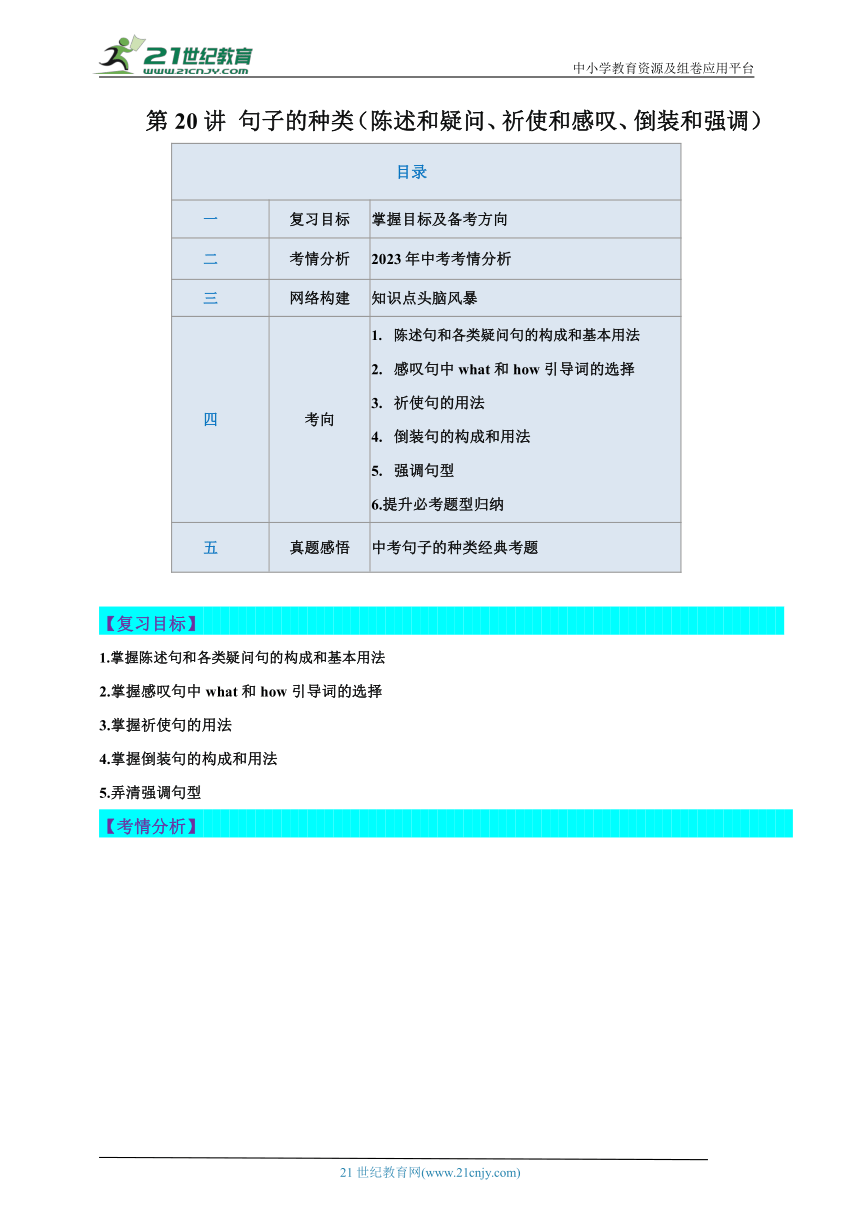 | |
| 格式 | doc | ||
| 文件大小 | 489.2KB | ||
| 资源类型 | 试卷 | ||
| 版本资源 | 通用版 | ||
| 科目 | 英语 | ||
| 更新时间 | 2024-03-26 23:14:59 | ||
图片预览

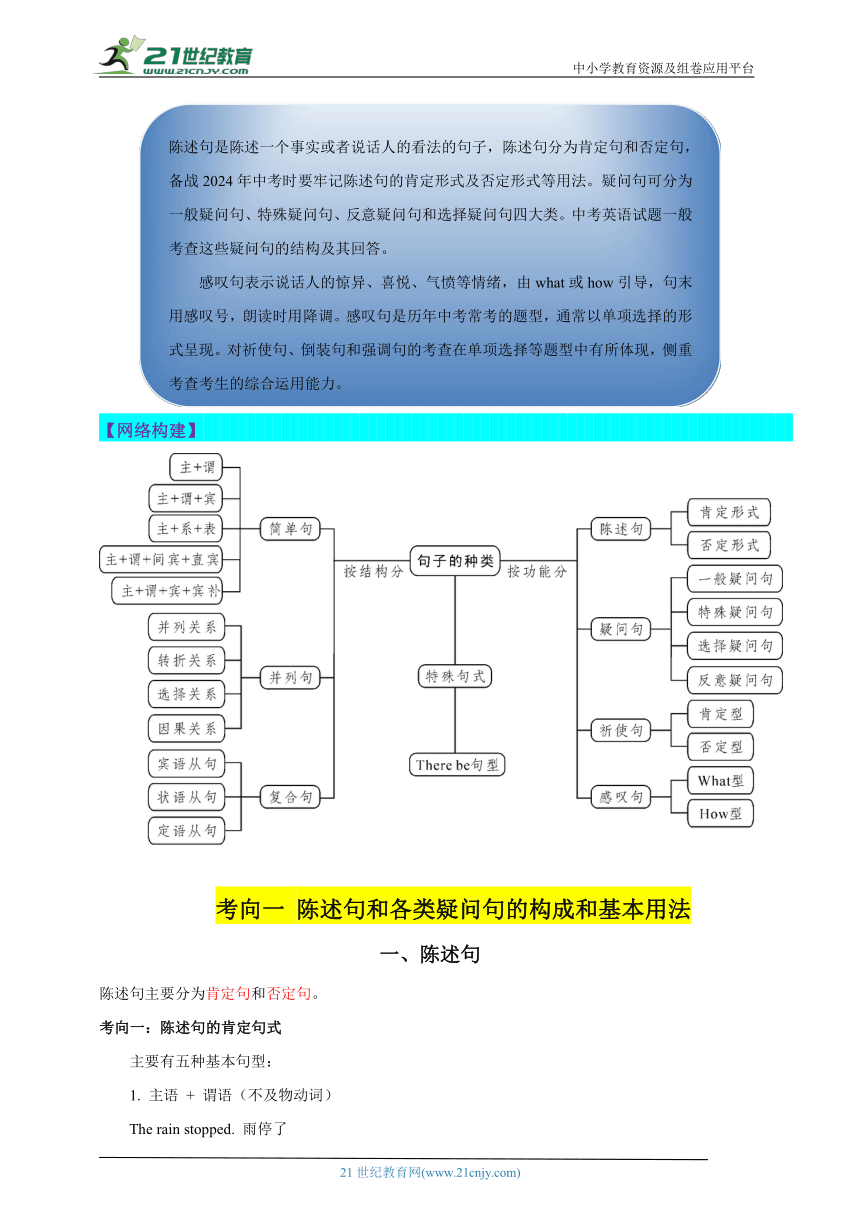
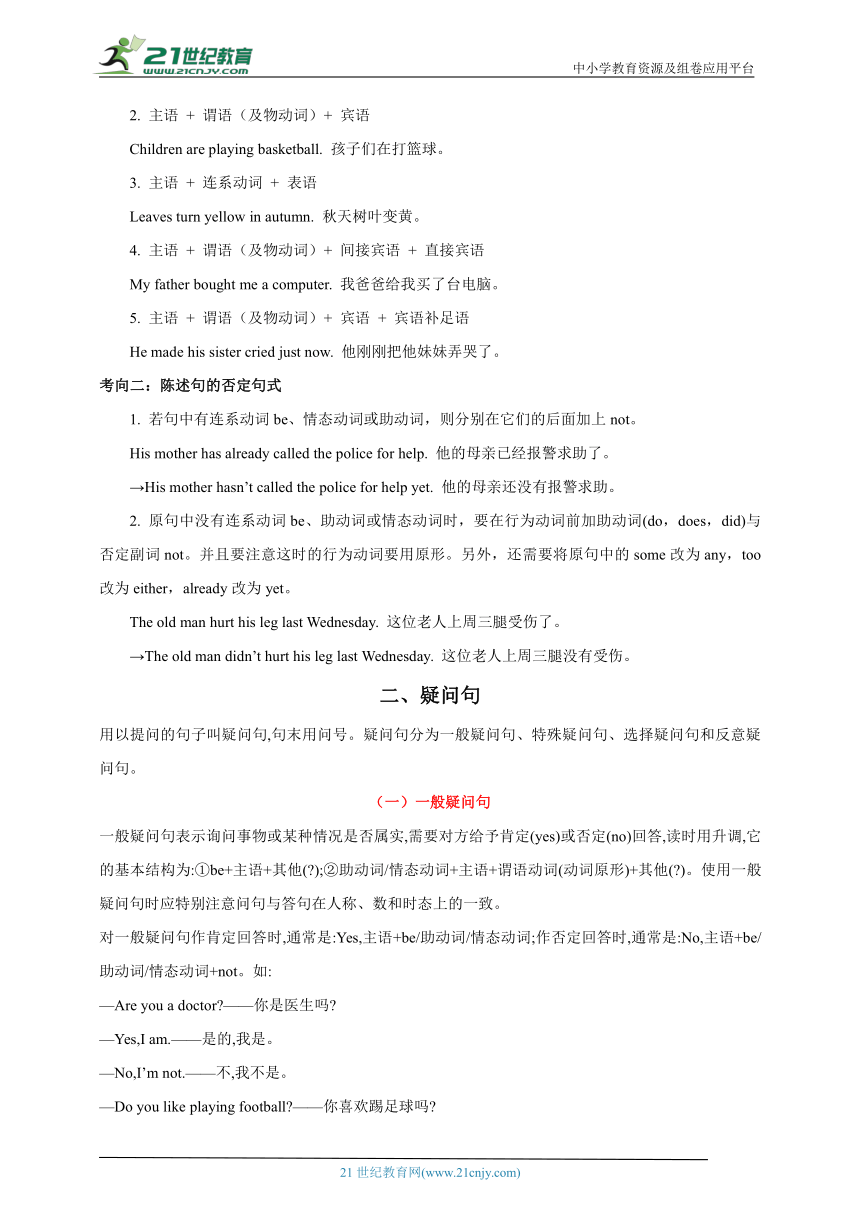
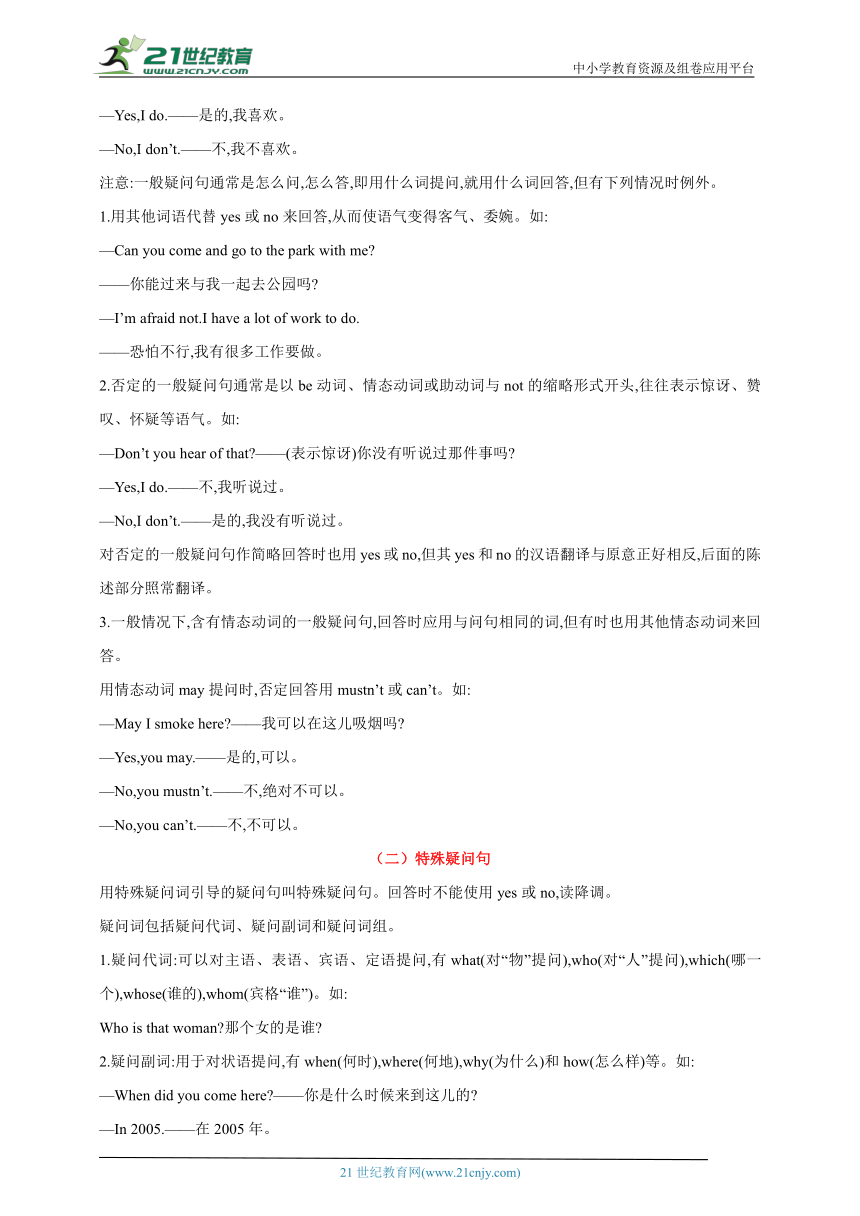
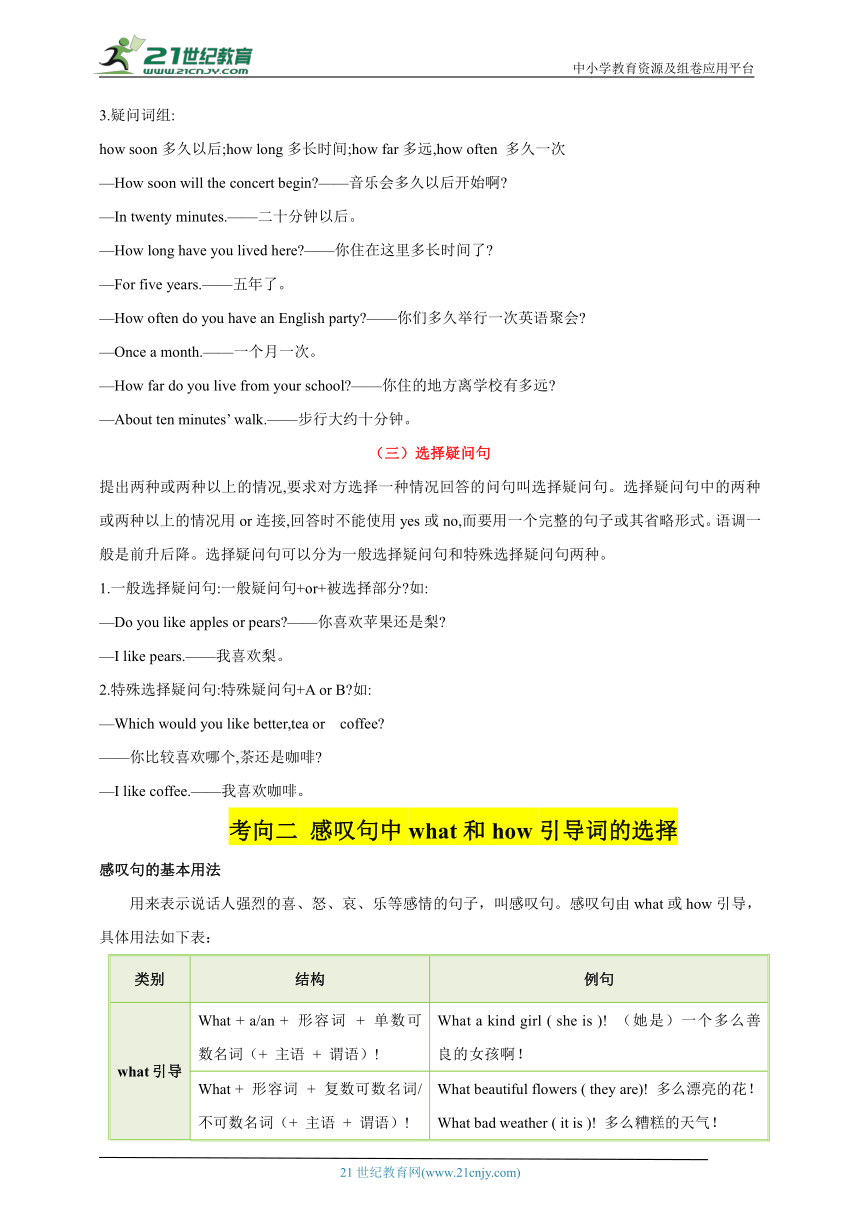
文档简介
中小学教育资源及组卷应用平台
第20讲 句子的种类(陈述和疑问、祈使和感叹、倒装和强调)
目录
一 复习目标 掌握目标及备考方向
二 考情分析 2023年中考考情分析
三 网络构建 知识点头脑风暴
四 考向 陈述句和各类疑问句的构成和基本用法感叹句中what和how引导词的选择祈使句的用法倒装句的构成和用法强调句型6.提升必考题型归纳
五 真题感悟 中考句子的种类经典考题
【复习目标】
1.掌握陈述句和各类疑问句的构成和基本用法
2.掌握感叹句中what和how引导词的选择
3.掌握祈使句的用法
4.掌握倒装句的构成和用法
5.弄清强调句型
【考情分析】
【网络构建】
考向一 陈述句和各类疑问句的构成和基本用法
一、陈述句
陈述句主要分为肯定句和否定句。
考向一:陈述句的肯定句式
主要有五种基本句型:
1. 主语 + 谓语(不及物动词)
The rain stopped. 雨停了
2. 主语 + 谓语(及物动词)+ 宾语
Children are playing basketball. 孩子们在打篮球。
3. 主语 + 连系动词 + 表语
Leaves turn yellow in autumn. 秋天树叶变黄。
4. 主语 + 谓语(及物动词)+ 间接宾语 + 直接宾语
My father bought me a computer. 我爸爸给我买了台电脑。
5. 主语 + 谓语(及物动词)+ 宾语 + 宾语补足语
He made his sister cried just now. 他刚刚把他妹妹弄哭了。
考向二:陈述句的否定句式
1. 若句中有连系动词be、情态动词或助动词,则分别在它们的后面加上not。
His mother has already called the police for help. 他的母亲已经报警求助了。
→His mother hasn’t called the police for help yet. 他的母亲还没有报警求助。
2. 原句中没有连系动词be、助动词或情态动词时,要在行为动词前加助动词(do,does,did)与否定副词not。并且要注意这时的行为动词要用原形。另外,还需要将原句中的some改为any,too改为either,already改为yet。
The old man hurt his leg last Wednesday. 这位老人上周三腿受伤了。
→The old man didn’t hurt his leg last Wednesday. 这位老人上周三腿没有受伤。
疑问句
用以提问的句子叫疑问句,句末用问号。疑问句分为一般疑问句、特殊疑问句、选择疑问句和反意疑问句。
(一)一般疑问句
一般疑问句表示询问事物或某种情况是否属实,需要对方给予肯定(yes)或否定(no)回答,读时用升调,它的基本结构为:①be+主语+其他( );②助动词/情态动词+主语+谓语动词(动词原形)+其他( )。使用一般疑问句时应特别注意问句与答句在人称、数和时态上的一致。
对一般疑问句作肯定回答时,通常是:Yes,主语+be/助动词/情态动词;作否定回答时,通常是:No,主语+be/助动词/情态动词+not。如:
—Are you a doctor ——你是医生吗
—Yes,I am.——是的,我是。
—No,I’m not.——不,我不是。
—Do you like playing football ——你喜欢踢足球吗
—Yes,I do.——是的,我喜欢。
—No,I don’t.——不,我不喜欢。
注意:一般疑问句通常是怎么问,怎么答,即用什么词提问,就用什么词回答,但有下列情况时例外。
1.用其他词语代替yes或no来回答,从而使语气变得客气、委婉。如:
—Can you come and go to the park with me
——你能过来与我一起去公园吗
—I’m afraid not.I have a lot of work to do.
——恐怕不行,我有很多工作要做。
2.否定的一般疑问句通常是以be动词、情态动词或助动词与not的缩略形式开头,往往表示惊讶、赞叹、怀疑等语气。如:
—Don’t you hear of that ——(表示惊讶)你没有听说过那件事吗
—Yes,I do.——不,我听说过。
—No,I don’t.——是的,我没有听说过。
对否定的一般疑问句作简略回答时也用yes或no,但其yes和no的汉语翻译与原意正好相反,后面的陈述部分照常翻译。
3.一般情况下,含有情态动词的一般疑问句,回答时应用与问句相同的词,但有时也用其他情态动词来回答。
用情态动词may提问时,否定回答用mustn’t或can’t。如:
—May I smoke here ——我可以在这儿吸烟吗
—Yes,you may.——是的,可以。
—No,you mustn’t.——不,绝对不可以。
—No,you can’t.——不,不可以。
(二)特殊疑问句
用特殊疑问词引导的疑问句叫特殊疑问句。回答时不能使用yes或no,读降调。
疑问词包括疑问代词、疑问副词和疑问词组。
1.疑问代词:可以对主语、表语、宾语、定语提问,有what(对“物”提问),who(对“人”提问),which(哪一个),whose(谁的),whom(宾格“谁”)。如:
Who is that woman 那个女的是谁
2.疑问副词:用于对状语提问,有when(何时),where(何地),why(为什么)和how(怎么样)等。如:
—When did you come here ——你是什么时候来到这儿的
—In 2005.——在2005年。
3.疑问词组:
how soon多久以后;how long多长时间;how far多远,how often 多久一次
—How soon will the concert begin ——音乐会多久以后开始啊
—In twenty minutes.——二十分钟以后。
—How long have you lived here ——你住在这里多长时间了
—For five years.——五年了。
—How often do you have an English party ——你们多久举行一次英语聚会
—Once a month.——一个月一次。
—How far do you live from your school ——你住的地方离学校有多远
—About ten minutes’ walk.——步行大约十分钟。
(三)选择疑问句
提出两种或两种以上的情况,要求对方选择一种情况回答的问句叫选择疑问句。选择疑问句中的两种或两种以上的情况用or连接,回答时不能使用yes或no,而要用一个完整的句子或其省略形式。语调一般是前升后降。选择疑问句可以分为一般选择疑问句和特殊选择疑问句两种。
1.一般选择疑问句:一般疑问句+or+被选择部分 如:
—Do you like apples or pears ——你喜欢苹果还是梨
—I like pears.——我喜欢梨。
2.特殊选择疑问句:特殊疑问句+A or B 如:
—Which would you like better,tea or coffee
——你比较喜欢哪个,茶还是咖啡
—I like coffee.——我喜欢咖啡。
考向二 感叹句中what和how引导词的选择
感叹句的基本用法
用来表示说话人强烈的喜、怒、哀、乐等感情的句子,叫感叹句。感叹句由what或how引导,具体用法如下表:
类别 结构 例句
what引导 What + a/an + 形容词 + 单数可数名词(+ 主语 + 谓语)! What a kind girl ( she is )! (她是)一个多么善良的女孩啊!
What + 形容词 + 复数可数名词/不可数名词(+ 主语 + 谓语)! What beautiful flowers ( they are)! 多么漂亮的花!What bad weather ( it is )! 多么糟糕的天气!
how引导 How + 主语 + 谓语! How time flies! 时间飞逝!
How + 形容词/副词(+ 主语 + 谓语)! How brave ( the hero is )!(这个英雄)真勇敢!How slowly he walks! 他走得多慢啊!
How + 形容词 + a/an + 单数可数名词(+ 主语 + 谓语)! How clever ( a boy he is )! (他是)一个多么聪明的男孩啊!
3.特殊形式的感叹句①在陈述句、祈使句或疑问句句尾加感叹号,表示某种强烈感情。Do read it carefully!②用一个词或词组表达强烈感情的句子。Great !Look out!③Here/There开头的感叹句: Here we are!There goes the bell!
做题口诀:删主谓,看左一,左一名词用what,形名牵手用what,左一形副就用how,有the也用how.
考向三 祈使句的用法
祈使句的基本用法
祈使句是用来表示命令、请求、建议或劝告等的句子。常省略主语,谓语动词用原形。
1. 肯定的祈使句
①句型:动词原形+其他成分。
Be careful! 小心!
②"Do+祈使句"表示一种强烈的感情或请求,do起强调作用。
③please用在祈使句中可以表示一种客气的语气,但please用在句末时,必须用逗号与其余部分隔开。
Close the door, please. 请关门。
2. 否定的祈使句
①常用句型:Don’t+动词原形+其他成分。
Don’t be late for school again! 别再迟到了!
②用Never开头:Never+动词原形+其他成分。
Never leave today’s work for tomorrow! 不要把今天的工作留到明天!
3. Let引导的祈使句
以Let开头的句子也是祈使句,表示陈述和建议。其否定形式有两种:Let...not或Don’t...
Let us not be late. 让我们不要迟到。
Don’t let the boy play football in the street. 不要让这个男孩在街上踢足球。
祈使句的应答语
1. 以Let’s开头的祈使句,其答语常用Good idea. /OK. /Yes, I’d love to. 等。
—Let’s go to the park. 让我们去公园吧。
—Good idea. 好主意。
2. 其他肯定祈使句的应答语为Yes, I will. ;否定祈使句的应答语为Sorry/No, I won’t(do it again). 。
—It’s going to rain. Remember to take an umbrella with you. 就要下雨了。记着带上雨伞。
—Thanks, I will. 谢谢,我会的。
—Don’t play with my cat. 不要和我的猫玩。
—Sorry, I won’t do it again. 对不起,我将不再那样做了。
考向四 倒装句的构成和用法
倒装句是英语中常见的句式。对于倒装句,主要考查学生在特定的结构中正确使用部分倒装和完全倒装,以及"so+助动词/情态动/系动词+主语"的用法。
部分倒装
倒装条件 例句
一般疑问句中,将助动词放到主语之前,构成部分倒装。 Do you like eating apples 你喜欢吃苹果吗?
特殊疑问句中,疑问词作宾语、表语或状语,需要将其置于句首,将助动词置于主语前构成部分倒装。 Where have you been these days 这些天你到哪里去了?
"only+状语/状语从句"位于句首时,句子要用部分倒装。 Only in this way can you improve your grade. 只有用这种方法你才能提高自己的成绩。
表示否定意义的词或短语,如little, hardly, never, in no case, seldom等,放在句首时,句子要用部分倒装。 Hardly a day goes by without a visit from someone. 几乎没有一天没有来访者。
虚拟条件句中,从句谓语部分中有were, had或should可省略if,把were,had或should提到主语前。 Should we succeed, we would be rich. 我们一旦成功就发财了。
" so... that..."句型中,"so+adj. /adv."位于句首时。 So fast did he run that we couldn’t catch up with him. 他跑得如此快,以至于我们赶不上他。
表示"也(不) ……"的句式,即"so/neither/nor+助动词/情态动词/be+主语"形式。 I don’t like it; neither do I care it. 我不喜欢它,也不在意它。
某些含有否定含义的词位于句首时,如not only…but also,hardly…when,no…sooner…than, not…until等,主句用部分倒装。 Not until the teacher came in did the students stop talking.直到老师进来学生们才停止讲话。
may表示祝愿时用部分倒装。 May you have a good time! 祝你玩得愉快!
【易错警示】1.特殊疑问句中,如果疑问词作主语或修饰主语时,则不用倒装。Who knows the answer to this question 谁知道这个问题的答案?2. "so+主语+谓语"结构不用倒装。—Jimmy is good at playing football. 吉米足球踢得很好。—So he is. 的确。
完全倒装
倒装条件 例句
表示方位、地点、时间、次序的词,如in, out,up, there, then, here, first等放在句首,若主语是名词而不是代词时,句子用完全倒装 Here comes the bus. 公交车来了。Here he comes. 他来了。
分词短语置于句首时,句子用完全倒装 Lying on the couch is an old lady. 躺在睡椅上的是一位老太太。
There be句型是全倒装的一种 There are a number of teachers and students in the school. 在这所学校有很多老师和学生。
作表语的such位于句首时 Such are the most powerful voices of our times!这些就是我们时代的最强音!
【巧学助记】全部倒装并不难,需要记住这几点;位置副词there句首,表语such提句前,介词短语表地点,全部倒装谓在前。
【辨析】so+助动词/be动词/情态动词+主语和neither+助动词/be动词/情态动词+主语的区别
区别
so+助动词/be动词/情态动词+主语 依附于肯定句,表示前边的肯定情况也适合后边的人(物),意为"……也……"。
neither+助动词/be动词/情态动词+主语 依附于否定句,表示前边的否定情况也适合后边的人(物),意为"……也不……"。
Tom watched TV last night, so did Ann.汤姆昨晚看电视了,安也看了。
Mary didn’t watch TV last night, neither did Jim.玛丽昨晚没有看电视,吉姆也没看。
考向四 强调句型
强调句(The Emphatic Pattern)是一种修辞,是人们为了表达自己的意愿或情感而使用的一种形式。通过这种方式对句子中的某个部分进行强调,从而起到修辞的作用。 人们在交际过程中,为了使自己的思想能为听者或读者恰当的理解,必须突出重要的内容,这就需要运用强调的手段。
强调句的基本句型结构
1、强调句的陈述句句型为:
It is /was+被强调的部分+that/who引导的从句+原句其他部分。
[例]It is because he is ill that he can’t come.是因为生病他才没有来。
2、强调句的一般疑问句型(把is/ was提到it前面):
Is / Was +it+被强调的部分+that/ who/ whom引导的从句+原句其他的部分。
[例]Is it because he is ill that he can’t come 是因为生病他才没有来吗
3、强调句的特殊疑问句型:
被强调部分特殊疑问词(When /Where/ Why/ Who/ What/ How )+is/ was +it +that从句+原句的其他部分。
[例]Why is it that he can’t come 他为什么不能来
【要点提示】
1、It is/was…that…强调句型中,被强调的部分(通常是句子的主语、状语、宾语或宾语补足语)放在is/was的后面,如被强调的是人,则后面可用who,whom等代替。
[例]
普通句:He met an old friend in the park yesterday. 他昨天在公园碰见一个老朋友。
上述句子可以通过强调句型对除谓语以外的不同成分进行强调。
[例]
①It was he who/that met an old friend in the park yesterday.(强调主语)
②It was an old friend that/who he met in the park yesterday.(强调宾语)
③It was in the park that he met an old friend yesterday.(强调地点状语)
④It was yesterday that he met an old friend in he park. (强调时间状语)
2.主谓一致。“It is/was…that…”强调句型中,无论强调的主语是单数还是复数,强调句中所用的be动词始终都是is或者是was,如果强调的是将来或者是正在发生的事情或正在进行的动作的时候,只能用is。如果强调过去已经完成的就用was。
[例]
①It is some books that I am going to buy.我要买的是一些书。
②It is Western health-care system that (which) are spending huge sums of money on the surgical treatment of the disease.正是西方国家医疗保健机构,在心脏病的手术治疗上开支巨大。
③ It was Ann Peters' husband that (who) rushed her to a nearby hospital last night.昨晚,正是安妮,彼德的丈夫,立即送她去了附近医院。
3.连接词。在这种强调句式中,一般用that引出句子的其他部分。如果被强调的部分是表示人的意义的名词时,可以用who代替that引出句子的其他部分;在强调状语的时候,无论被强调的部分是表示时间还是地点, 都不能用when或者where,连接词只能用that。
4、强调句去掉了it is/ was…+that之后,对于句子的完整性不造成影响。
It was(过去时) I who/that met(过去时) him in the park this morning.
所以当 it is/was …… that/who 删除时,句子的结构依旧完整(即 I met him in the park this morning.)
5、It is/was…that…强调句型的被强调部分如果是原因状语从句,只能由because引导,不能由since、as或why引导。
[例]
It was because the water had risen that they could not cross the river.正是由于水涨了,他们没有渡过河去。(不用ah或since)
6.It is/was…that…强调句型中,that作宾语时可以省略。
[例]
①It was a new dictionary (that) Father bought for me.父亲给我买的是一本新字典。
②Was it her (that) you were talking about 你刚才是和她在谈话吗?
课堂练习
一、单项选择
1.(2023·甘肃平凉·校考三模)Look, it’s raining heavily outside. You’d better ________ out.
A.go B.not go C.don’t go D.not to go
2.(2023·辽宁盘锦·校联考一模)These flowers don’t always need _______, so you _____them every day.
A.to water; don’t need to water B.watering; needn’t to water
C.to water; don’t need water D.watering; don’t need to water
3.(2023·江苏常州·统考一模)—Yuan Longping spent all his life on the research and development of better rice plants.
—That’s true. We ________ praise him too much.
A.must B.mustn’t C.can D.can’t
4.(2023·上海嘉定·统考一模)You will lose marks in the exam if you ________ your handwriting.
A.don’t improve B.didn’t improve C.won’t improve D.isn’t improving
5.(2022·黑龙江绥化·统考三模)You ________ your work tonight. It’s time to go to bed.
A.don’t need finishing B.needn’t finish C.needn’t to finish
6.(2022·甘肃陇南·校考模拟预测)You’d better ________ the TV. It’s time for supper.
A.not to turn on B.to not turn on C.not turn on D.not turning on
7.(2023·吉林长春·吉林省实验校考模拟预测)—________ does it take to get to the nearest supermarket
—About half an hour.
A.How far B.How long C.How soon D.How often
8.(2023·吉林长春·长春市解放大路学校校考模拟预测)—________ will your mom come back
—In two weeks.
A.How soon B.How often C.How long D.How much
9.(2023·黑龙江绥化·校考模拟预测)She’s been to the Great Wall many times, ________
A.has she B.isn’t she C.hasn’t she
10.(2023·吉林长春·统考模拟预测)— Have you ever been to Beijing or Shanghai, Tina
—________. I visited the Great Wall.
A.Yes, I have B.No, I haven’t C.Shanghai D.Beijing
11.(2023·吉林长春·长春市解放大路学校校考模拟预测)Take action now, ________ you can’t achieve your goal.
A.but B.so C.and D.or
12.(2023·福建南平·武夷山一中校考模拟预测)Never give up your dream, ________ you may make it come true one day.
A.but B.and C.or
13.(2023·福建漳州·校联考模拟预测)Work hard, ________ you’ll find a way out.
A.so B.or C.and
14.(2023·云南昆明·昆明八中校考模拟预测)— Do you know the new GPT-4 can be used in language learning
— Really ________ big news!
A.How B.How a C.What D.What a
15.(2023·吉林四平·校联考模拟预测)________ successful speech Cathy has made after getting ready for it for a long time!
A.What B.What a C.How
16.(2023·吉林长春·校联考模拟预测)________ great progress Chinese space station has made! We are proud of it.
A.What B.What a C.What an D.How
17.(2023·吉林白城·校联考模拟预测)—All of my classmates have passed the English test.
—________ exciting the news is !
A.How B.What C.What an
18.(2023·吉林长春·长春市解放大路学校校考模拟预测)________ proud the Chinese people were when they saw so many China-made products during the FIFA World Cup Qatar 2022!
A.What B.What a C.How D.How a
19.(2022·江苏无锡·江苏省锡山高级中学实验学校校考二模)—I think the plan is just a waste of time!
—Well. If you don’t support it, ______.
A.so will they B.so do they C.neither do they D.neither will they
20.(2023·黑龙江绥化·校考二模)Only by working hard ________ achieve our dreams.
A.we can B.can we C.they can
真题演练
1.(2023·湖南湘西·统考中考真题)— ________ do you usually go to bed
—At 10 o’clock.
A.While B.What time C.How often
2.(2023·江苏淮安·统考中考真题)The C919, China’s self-made large plane, is now in use. ________ exciting the news is!
A.How B.How an C.What D.What an
3.(2023·西藏·统考中考真题)—Luosang, ________
—I went there by plane.
A.why did you go to Lhasa
B.when did you go to Lhasa
C.how did you go to Lhasa
D.who did you go to Lhasa with
4.(2023·西藏·统考中考真题)________ strong our country is! I’m so proud of her.
A.How B.What C.What a D.What an
5.(2023·西藏·统考中考真题)—You look so young. Are you a student
—________. I’m a student from China.
A.Yes, I do B.Yes, I am C.No, I don’t D.No, I won’t
6.(2023·西藏·统考中考真题)________ swimming in the river! It’s dangerous!
A.Go B.Goes C.Don’t go D.To go
7.(2023·辽宁盘锦·统考中考真题)—Good morning, madam! ________ beef do you want
—Two kilos, please.
A.How much B.How many C.How often D.How far
8.(2023·辽宁盘锦·统考中考真题)The cheers filled the air. ________ an exciting basketball game!
A.What B.Why C.Who D.How
9.(2023·辽宁大连·统考中考真题)—________ you cook dishes
—Yes, I can. But they are simple.
A.Can B.Would C.Need D.Could
10.(2023·辽宁大连·统考中考真题)—________ can you see from the London Eye
—On a clear day, most of London.
A.Where B.How C.Why D.What
11.(2023·全国·九年级专题练习)________ it was to see the main sights of the world in the World Park!
A.How amazing day B.How an amazing day
C.What amazing day D.What an amazing day
12.(2023·吉林长春·统考中考真题)— Which season do you like better in Changchun, winter or autumn
— _______. I like playing with snow.
A.Yes, I do B.No, I don’t C.Winter D.Autumn
13.(2023·黑龙江·统考中考真题)—You haven’t visited the Palace Museum, have you
—________ How I wish to visit it some day!
A.No, I haven’t. B.Yes, I haven’t. C.Yes, I have.
14.(2022·西藏·统考中考真题)Don’t ________ any noise when you are in the library.
A.makes B.make C.making D.made
15.(2022·上海·统考中考真题)Have a balanced diet and exercise regularly _______ you will stay healthy.
A.and B.or C.but D.for
参考答案
真题演练
1-5 BACAB 6-10 CAAAD 11-15 DCABA
陈述句是陈述一个事实或者说话人的看法的句子,陈述句分为肯定句和否定句,备战2024年中考时要牢记陈述句的肯定形式及否定形式等用法。疑问句可分为一般疑问句、特殊疑问句、反意疑问句和选择疑问句四大类。中考英语试题一般考查这些疑问句的结构及其回答。
感叹句表示说话人的惊异、喜悦、气愤等情绪,由what或how引导,句末用感叹号,朗读时用降调。感叹句是历年中考常考的题型,通常以单项选择的形式呈现。对祈使句、倒装句和强调句的考查在单项选择等题型中有所体现,侧重考查考生的综合运用能力。
21世纪教育网 www.21cnjy.com 精品试卷·第 2 页 (共 2 页)
HYPERLINK "http://21世纪教育网(www.21cnjy.com)
" 21世纪教育网(www.21cnjy.com)
第20讲 句子的种类(陈述和疑问、祈使和感叹、倒装和强调)
目录
一 复习目标 掌握目标及备考方向
二 考情分析 2023年中考考情分析
三 网络构建 知识点头脑风暴
四 考向 陈述句和各类疑问句的构成和基本用法感叹句中what和how引导词的选择祈使句的用法倒装句的构成和用法强调句型6.提升必考题型归纳
五 真题感悟 中考句子的种类经典考题
【复习目标】
1.掌握陈述句和各类疑问句的构成和基本用法
2.掌握感叹句中what和how引导词的选择
3.掌握祈使句的用法
4.掌握倒装句的构成和用法
5.弄清强调句型
【考情分析】
【网络构建】
考向一 陈述句和各类疑问句的构成和基本用法
一、陈述句
陈述句主要分为肯定句和否定句。
考向一:陈述句的肯定句式
主要有五种基本句型:
1. 主语 + 谓语(不及物动词)
The rain stopped. 雨停了
2. 主语 + 谓语(及物动词)+ 宾语
Children are playing basketball. 孩子们在打篮球。
3. 主语 + 连系动词 + 表语
Leaves turn yellow in autumn. 秋天树叶变黄。
4. 主语 + 谓语(及物动词)+ 间接宾语 + 直接宾语
My father bought me a computer. 我爸爸给我买了台电脑。
5. 主语 + 谓语(及物动词)+ 宾语 + 宾语补足语
He made his sister cried just now. 他刚刚把他妹妹弄哭了。
考向二:陈述句的否定句式
1. 若句中有连系动词be、情态动词或助动词,则分别在它们的后面加上not。
His mother has already called the police for help. 他的母亲已经报警求助了。
→His mother hasn’t called the police for help yet. 他的母亲还没有报警求助。
2. 原句中没有连系动词be、助动词或情态动词时,要在行为动词前加助动词(do,does,did)与否定副词not。并且要注意这时的行为动词要用原形。另外,还需要将原句中的some改为any,too改为either,already改为yet。
The old man hurt his leg last Wednesday. 这位老人上周三腿受伤了。
→The old man didn’t hurt his leg last Wednesday. 这位老人上周三腿没有受伤。
疑问句
用以提问的句子叫疑问句,句末用问号。疑问句分为一般疑问句、特殊疑问句、选择疑问句和反意疑问句。
(一)一般疑问句
一般疑问句表示询问事物或某种情况是否属实,需要对方给予肯定(yes)或否定(no)回答,读时用升调,它的基本结构为:①be+主语+其他( );②助动词/情态动词+主语+谓语动词(动词原形)+其他( )。使用一般疑问句时应特别注意问句与答句在人称、数和时态上的一致。
对一般疑问句作肯定回答时,通常是:Yes,主语+be/助动词/情态动词;作否定回答时,通常是:No,主语+be/助动词/情态动词+not。如:
—Are you a doctor ——你是医生吗
—Yes,I am.——是的,我是。
—No,I’m not.——不,我不是。
—Do you like playing football ——你喜欢踢足球吗
—Yes,I do.——是的,我喜欢。
—No,I don’t.——不,我不喜欢。
注意:一般疑问句通常是怎么问,怎么答,即用什么词提问,就用什么词回答,但有下列情况时例外。
1.用其他词语代替yes或no来回答,从而使语气变得客气、委婉。如:
—Can you come and go to the park with me
——你能过来与我一起去公园吗
—I’m afraid not.I have a lot of work to do.
——恐怕不行,我有很多工作要做。
2.否定的一般疑问句通常是以be动词、情态动词或助动词与not的缩略形式开头,往往表示惊讶、赞叹、怀疑等语气。如:
—Don’t you hear of that ——(表示惊讶)你没有听说过那件事吗
—Yes,I do.——不,我听说过。
—No,I don’t.——是的,我没有听说过。
对否定的一般疑问句作简略回答时也用yes或no,但其yes和no的汉语翻译与原意正好相反,后面的陈述部分照常翻译。
3.一般情况下,含有情态动词的一般疑问句,回答时应用与问句相同的词,但有时也用其他情态动词来回答。
用情态动词may提问时,否定回答用mustn’t或can’t。如:
—May I smoke here ——我可以在这儿吸烟吗
—Yes,you may.——是的,可以。
—No,you mustn’t.——不,绝对不可以。
—No,you can’t.——不,不可以。
(二)特殊疑问句
用特殊疑问词引导的疑问句叫特殊疑问句。回答时不能使用yes或no,读降调。
疑问词包括疑问代词、疑问副词和疑问词组。
1.疑问代词:可以对主语、表语、宾语、定语提问,有what(对“物”提问),who(对“人”提问),which(哪一个),whose(谁的),whom(宾格“谁”)。如:
Who is that woman 那个女的是谁
2.疑问副词:用于对状语提问,有when(何时),where(何地),why(为什么)和how(怎么样)等。如:
—When did you come here ——你是什么时候来到这儿的
—In 2005.——在2005年。
3.疑问词组:
how soon多久以后;how long多长时间;how far多远,how often 多久一次
—How soon will the concert begin ——音乐会多久以后开始啊
—In twenty minutes.——二十分钟以后。
—How long have you lived here ——你住在这里多长时间了
—For five years.——五年了。
—How often do you have an English party ——你们多久举行一次英语聚会
—Once a month.——一个月一次。
—How far do you live from your school ——你住的地方离学校有多远
—About ten minutes’ walk.——步行大约十分钟。
(三)选择疑问句
提出两种或两种以上的情况,要求对方选择一种情况回答的问句叫选择疑问句。选择疑问句中的两种或两种以上的情况用or连接,回答时不能使用yes或no,而要用一个完整的句子或其省略形式。语调一般是前升后降。选择疑问句可以分为一般选择疑问句和特殊选择疑问句两种。
1.一般选择疑问句:一般疑问句+or+被选择部分 如:
—Do you like apples or pears ——你喜欢苹果还是梨
—I like pears.——我喜欢梨。
2.特殊选择疑问句:特殊疑问句+A or B 如:
—Which would you like better,tea or coffee
——你比较喜欢哪个,茶还是咖啡
—I like coffee.——我喜欢咖啡。
考向二 感叹句中what和how引导词的选择
感叹句的基本用法
用来表示说话人强烈的喜、怒、哀、乐等感情的句子,叫感叹句。感叹句由what或how引导,具体用法如下表:
类别 结构 例句
what引导 What + a/an + 形容词 + 单数可数名词(+ 主语 + 谓语)! What a kind girl ( she is )! (她是)一个多么善良的女孩啊!
What + 形容词 + 复数可数名词/不可数名词(+ 主语 + 谓语)! What beautiful flowers ( they are)! 多么漂亮的花!What bad weather ( it is )! 多么糟糕的天气!
how引导 How + 主语 + 谓语! How time flies! 时间飞逝!
How + 形容词/副词(+ 主语 + 谓语)! How brave ( the hero is )!(这个英雄)真勇敢!How slowly he walks! 他走得多慢啊!
How + 形容词 + a/an + 单数可数名词(+ 主语 + 谓语)! How clever ( a boy he is )! (他是)一个多么聪明的男孩啊!
3.特殊形式的感叹句①在陈述句、祈使句或疑问句句尾加感叹号,表示某种强烈感情。Do read it carefully!②用一个词或词组表达强烈感情的句子。Great !Look out!③Here/There开头的感叹句: Here we are!There goes the bell!
做题口诀:删主谓,看左一,左一名词用what,形名牵手用what,左一形副就用how,有the也用how.
考向三 祈使句的用法
祈使句的基本用法
祈使句是用来表示命令、请求、建议或劝告等的句子。常省略主语,谓语动词用原形。
1. 肯定的祈使句
①句型:动词原形+其他成分。
Be careful! 小心!
②"Do+祈使句"表示一种强烈的感情或请求,do起强调作用。
③please用在祈使句中可以表示一种客气的语气,但please用在句末时,必须用逗号与其余部分隔开。
Close the door, please. 请关门。
2. 否定的祈使句
①常用句型:Don’t+动词原形+其他成分。
Don’t be late for school again! 别再迟到了!
②用Never开头:Never+动词原形+其他成分。
Never leave today’s work for tomorrow! 不要把今天的工作留到明天!
3. Let引导的祈使句
以Let开头的句子也是祈使句,表示陈述和建议。其否定形式有两种:Let...not或Don’t...
Let us not be late. 让我们不要迟到。
Don’t let the boy play football in the street. 不要让这个男孩在街上踢足球。
祈使句的应答语
1. 以Let’s开头的祈使句,其答语常用Good idea. /OK. /Yes, I’d love to. 等。
—Let’s go to the park. 让我们去公园吧。
—Good idea. 好主意。
2. 其他肯定祈使句的应答语为Yes, I will. ;否定祈使句的应答语为Sorry/No, I won’t(do it again). 。
—It’s going to rain. Remember to take an umbrella with you. 就要下雨了。记着带上雨伞。
—Thanks, I will. 谢谢,我会的。
—Don’t play with my cat. 不要和我的猫玩。
—Sorry, I won’t do it again. 对不起,我将不再那样做了。
考向四 倒装句的构成和用法
倒装句是英语中常见的句式。对于倒装句,主要考查学生在特定的结构中正确使用部分倒装和完全倒装,以及"so+助动词/情态动/系动词+主语"的用法。
部分倒装
倒装条件 例句
一般疑问句中,将助动词放到主语之前,构成部分倒装。 Do you like eating apples 你喜欢吃苹果吗?
特殊疑问句中,疑问词作宾语、表语或状语,需要将其置于句首,将助动词置于主语前构成部分倒装。 Where have you been these days 这些天你到哪里去了?
"only+状语/状语从句"位于句首时,句子要用部分倒装。 Only in this way can you improve your grade. 只有用这种方法你才能提高自己的成绩。
表示否定意义的词或短语,如little, hardly, never, in no case, seldom等,放在句首时,句子要用部分倒装。 Hardly a day goes by without a visit from someone. 几乎没有一天没有来访者。
虚拟条件句中,从句谓语部分中有were, had或should可省略if,把were,had或should提到主语前。 Should we succeed, we would be rich. 我们一旦成功就发财了。
" so... that..."句型中,"so+adj. /adv."位于句首时。 So fast did he run that we couldn’t catch up with him. 他跑得如此快,以至于我们赶不上他。
表示"也(不) ……"的句式,即"so/neither/nor+助动词/情态动词/be+主语"形式。 I don’t like it; neither do I care it. 我不喜欢它,也不在意它。
某些含有否定含义的词位于句首时,如not only…but also,hardly…when,no…sooner…than, not…until等,主句用部分倒装。 Not until the teacher came in did the students stop talking.直到老师进来学生们才停止讲话。
may表示祝愿时用部分倒装。 May you have a good time! 祝你玩得愉快!
【易错警示】1.特殊疑问句中,如果疑问词作主语或修饰主语时,则不用倒装。Who knows the answer to this question 谁知道这个问题的答案?2. "so+主语+谓语"结构不用倒装。—Jimmy is good at playing football. 吉米足球踢得很好。—So he is. 的确。
完全倒装
倒装条件 例句
表示方位、地点、时间、次序的词,如in, out,up, there, then, here, first等放在句首,若主语是名词而不是代词时,句子用完全倒装 Here comes the bus. 公交车来了。Here he comes. 他来了。
分词短语置于句首时,句子用完全倒装 Lying on the couch is an old lady. 躺在睡椅上的是一位老太太。
There be句型是全倒装的一种 There are a number of teachers and students in the school. 在这所学校有很多老师和学生。
作表语的such位于句首时 Such are the most powerful voices of our times!这些就是我们时代的最强音!
【巧学助记】全部倒装并不难,需要记住这几点;位置副词there句首,表语such提句前,介词短语表地点,全部倒装谓在前。
【辨析】so+助动词/be动词/情态动词+主语和neither+助动词/be动词/情态动词+主语的区别
区别
so+助动词/be动词/情态动词+主语 依附于肯定句,表示前边的肯定情况也适合后边的人(物),意为"……也……"。
neither+助动词/be动词/情态动词+主语 依附于否定句,表示前边的否定情况也适合后边的人(物),意为"……也不……"。
Tom watched TV last night, so did Ann.汤姆昨晚看电视了,安也看了。
Mary didn’t watch TV last night, neither did Jim.玛丽昨晚没有看电视,吉姆也没看。
考向四 强调句型
强调句(The Emphatic Pattern)是一种修辞,是人们为了表达自己的意愿或情感而使用的一种形式。通过这种方式对句子中的某个部分进行强调,从而起到修辞的作用。 人们在交际过程中,为了使自己的思想能为听者或读者恰当的理解,必须突出重要的内容,这就需要运用强调的手段。
强调句的基本句型结构
1、强调句的陈述句句型为:
It is /was+被强调的部分+that/who引导的从句+原句其他部分。
[例]It is because he is ill that he can’t come.是因为生病他才没有来。
2、强调句的一般疑问句型(把is/ was提到it前面):
Is / Was +it+被强调的部分+that/ who/ whom引导的从句+原句其他的部分。
[例]Is it because he is ill that he can’t come 是因为生病他才没有来吗
3、强调句的特殊疑问句型:
被强调部分特殊疑问词(When /Where/ Why/ Who/ What/ How )+is/ was +it +that从句+原句的其他部分。
[例]Why is it that he can’t come 他为什么不能来
【要点提示】
1、It is/was…that…强调句型中,被强调的部分(通常是句子的主语、状语、宾语或宾语补足语)放在is/was的后面,如被强调的是人,则后面可用who,whom等代替。
[例]
普通句:He met an old friend in the park yesterday. 他昨天在公园碰见一个老朋友。
上述句子可以通过强调句型对除谓语以外的不同成分进行强调。
[例]
①It was he who/that met an old friend in the park yesterday.(强调主语)
②It was an old friend that/who he met in the park yesterday.(强调宾语)
③It was in the park that he met an old friend yesterday.(强调地点状语)
④It was yesterday that he met an old friend in he park. (强调时间状语)
2.主谓一致。“It is/was…that…”强调句型中,无论强调的主语是单数还是复数,强调句中所用的be动词始终都是is或者是was,如果强调的是将来或者是正在发生的事情或正在进行的动作的时候,只能用is。如果强调过去已经完成的就用was。
[例]
①It is some books that I am going to buy.我要买的是一些书。
②It is Western health-care system that (which) are spending huge sums of money on the surgical treatment of the disease.正是西方国家医疗保健机构,在心脏病的手术治疗上开支巨大。
③ It was Ann Peters' husband that (who) rushed her to a nearby hospital last night.昨晚,正是安妮,彼德的丈夫,立即送她去了附近医院。
3.连接词。在这种强调句式中,一般用that引出句子的其他部分。如果被强调的部分是表示人的意义的名词时,可以用who代替that引出句子的其他部分;在强调状语的时候,无论被强调的部分是表示时间还是地点, 都不能用when或者where,连接词只能用that。
4、强调句去掉了it is/ was…+that之后,对于句子的完整性不造成影响。
It was(过去时) I who/that met(过去时) him in the park this morning.
所以当 it is/was …… that/who 删除时,句子的结构依旧完整(即 I met him in the park this morning.)
5、It is/was…that…强调句型的被强调部分如果是原因状语从句,只能由because引导,不能由since、as或why引导。
[例]
It was because the water had risen that they could not cross the river.正是由于水涨了,他们没有渡过河去。(不用ah或since)
6.It is/was…that…强调句型中,that作宾语时可以省略。
[例]
①It was a new dictionary (that) Father bought for me.父亲给我买的是一本新字典。
②Was it her (that) you were talking about 你刚才是和她在谈话吗?
课堂练习
一、单项选择
1.(2023·甘肃平凉·校考三模)Look, it’s raining heavily outside. You’d better ________ out.
A.go B.not go C.don’t go D.not to go
2.(2023·辽宁盘锦·校联考一模)These flowers don’t always need _______, so you _____them every day.
A.to water; don’t need to water B.watering; needn’t to water
C.to water; don’t need water D.watering; don’t need to water
3.(2023·江苏常州·统考一模)—Yuan Longping spent all his life on the research and development of better rice plants.
—That’s true. We ________ praise him too much.
A.must B.mustn’t C.can D.can’t
4.(2023·上海嘉定·统考一模)You will lose marks in the exam if you ________ your handwriting.
A.don’t improve B.didn’t improve C.won’t improve D.isn’t improving
5.(2022·黑龙江绥化·统考三模)You ________ your work tonight. It’s time to go to bed.
A.don’t need finishing B.needn’t finish C.needn’t to finish
6.(2022·甘肃陇南·校考模拟预测)You’d better ________ the TV. It’s time for supper.
A.not to turn on B.to not turn on C.not turn on D.not turning on
7.(2023·吉林长春·吉林省实验校考模拟预测)—________ does it take to get to the nearest supermarket
—About half an hour.
A.How far B.How long C.How soon D.How often
8.(2023·吉林长春·长春市解放大路学校校考模拟预测)—________ will your mom come back
—In two weeks.
A.How soon B.How often C.How long D.How much
9.(2023·黑龙江绥化·校考模拟预测)She’s been to the Great Wall many times, ________
A.has she B.isn’t she C.hasn’t she
10.(2023·吉林长春·统考模拟预测)— Have you ever been to Beijing or Shanghai, Tina
—________. I visited the Great Wall.
A.Yes, I have B.No, I haven’t C.Shanghai D.Beijing
11.(2023·吉林长春·长春市解放大路学校校考模拟预测)Take action now, ________ you can’t achieve your goal.
A.but B.so C.and D.or
12.(2023·福建南平·武夷山一中校考模拟预测)Never give up your dream, ________ you may make it come true one day.
A.but B.and C.or
13.(2023·福建漳州·校联考模拟预测)Work hard, ________ you’ll find a way out.
A.so B.or C.and
14.(2023·云南昆明·昆明八中校考模拟预测)— Do you know the new GPT-4 can be used in language learning
— Really ________ big news!
A.How B.How a C.What D.What a
15.(2023·吉林四平·校联考模拟预测)________ successful speech Cathy has made after getting ready for it for a long time!
A.What B.What a C.How
16.(2023·吉林长春·校联考模拟预测)________ great progress Chinese space station has made! We are proud of it.
A.What B.What a C.What an D.How
17.(2023·吉林白城·校联考模拟预测)—All of my classmates have passed the English test.
—________ exciting the news is !
A.How B.What C.What an
18.(2023·吉林长春·长春市解放大路学校校考模拟预测)________ proud the Chinese people were when they saw so many China-made products during the FIFA World Cup Qatar 2022!
A.What B.What a C.How D.How a
19.(2022·江苏无锡·江苏省锡山高级中学实验学校校考二模)—I think the plan is just a waste of time!
—Well. If you don’t support it, ______.
A.so will they B.so do they C.neither do they D.neither will they
20.(2023·黑龙江绥化·校考二模)Only by working hard ________ achieve our dreams.
A.we can B.can we C.they can
真题演练
1.(2023·湖南湘西·统考中考真题)— ________ do you usually go to bed
—At 10 o’clock.
A.While B.What time C.How often
2.(2023·江苏淮安·统考中考真题)The C919, China’s self-made large plane, is now in use. ________ exciting the news is!
A.How B.How an C.What D.What an
3.(2023·西藏·统考中考真题)—Luosang, ________
—I went there by plane.
A.why did you go to Lhasa
B.when did you go to Lhasa
C.how did you go to Lhasa
D.who did you go to Lhasa with
4.(2023·西藏·统考中考真题)________ strong our country is! I’m so proud of her.
A.How B.What C.What a D.What an
5.(2023·西藏·统考中考真题)—You look so young. Are you a student
—________. I’m a student from China.
A.Yes, I do B.Yes, I am C.No, I don’t D.No, I won’t
6.(2023·西藏·统考中考真题)________ swimming in the river! It’s dangerous!
A.Go B.Goes C.Don’t go D.To go
7.(2023·辽宁盘锦·统考中考真题)—Good morning, madam! ________ beef do you want
—Two kilos, please.
A.How much B.How many C.How often D.How far
8.(2023·辽宁盘锦·统考中考真题)The cheers filled the air. ________ an exciting basketball game!
A.What B.Why C.Who D.How
9.(2023·辽宁大连·统考中考真题)—________ you cook dishes
—Yes, I can. But they are simple.
A.Can B.Would C.Need D.Could
10.(2023·辽宁大连·统考中考真题)—________ can you see from the London Eye
—On a clear day, most of London.
A.Where B.How C.Why D.What
11.(2023·全国·九年级专题练习)________ it was to see the main sights of the world in the World Park!
A.How amazing day B.How an amazing day
C.What amazing day D.What an amazing day
12.(2023·吉林长春·统考中考真题)— Which season do you like better in Changchun, winter or autumn
— _______. I like playing with snow.
A.Yes, I do B.No, I don’t C.Winter D.Autumn
13.(2023·黑龙江·统考中考真题)—You haven’t visited the Palace Museum, have you
—________ How I wish to visit it some day!
A.No, I haven’t. B.Yes, I haven’t. C.Yes, I have.
14.(2022·西藏·统考中考真题)Don’t ________ any noise when you are in the library.
A.makes B.make C.making D.made
15.(2022·上海·统考中考真题)Have a balanced diet and exercise regularly _______ you will stay healthy.
A.and B.or C.but D.for
参考答案
真题演练
1-5 BACAB 6-10 CAAAD 11-15 DCABA
陈述句是陈述一个事实或者说话人的看法的句子,陈述句分为肯定句和否定句,备战2024年中考时要牢记陈述句的肯定形式及否定形式等用法。疑问句可分为一般疑问句、特殊疑问句、反意疑问句和选择疑问句四大类。中考英语试题一般考查这些疑问句的结构及其回答。
感叹句表示说话人的惊异、喜悦、气愤等情绪,由what或how引导,句末用感叹号,朗读时用降调。感叹句是历年中考常考的题型,通常以单项选择的形式呈现。对祈使句、倒装句和强调句的考查在单项选择等题型中有所体现,侧重考查考生的综合运用能力。
21世纪教育网 www.21cnjy.com 精品试卷·第 2 页 (共 2 页)
HYPERLINK "http://21世纪教育网(www.21cnjy.com)
" 21世纪教育网(www.21cnjy.com)
同课章节目录
- 词法
- 名词
- 动词和动词短语
- 动词语态
- 动词时态
- 助动词和情态动词
- 非谓语动词
- 冠词
- 代词
- 数词和量词
- 形容词副词及其比较等级
- 介词和介词短语
- 连词和感叹词
- 构词法
- 相似、相近词比较
- 句法
- 陈述句
- 一般疑问句和否定疑问句
- 特殊疑问句及选择疑问句
- 反意疑问句
- 存在句(There be句型)
- 宾语从句
- 定语从句
- 状语从句
- 主谓一致问题
- 简单句
- 并列句
- 复合句
- 主谓一致
- 主、表语从句
- 名词性从句
- 直接引语和间接引语
- 虚拟语气
- 感叹句
- 强调句
- 倒装句
- 祈使句
- 句子的成分
- 句子的分类
- 题型专区
- 单项选择部分
- 易错题
- 完形填空
- 阅读理解
- 词汇练习
- 听说训练
- 句型转换
- 补全对话
- 短文改错
- 翻译
- 书面表达
- 任务型阅读
- 语法填空
- 其他资料
